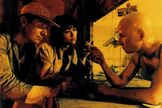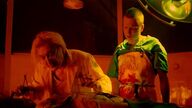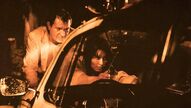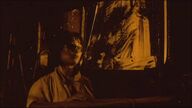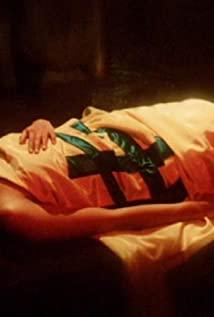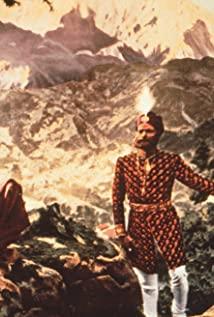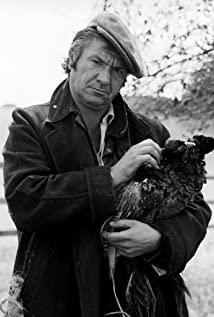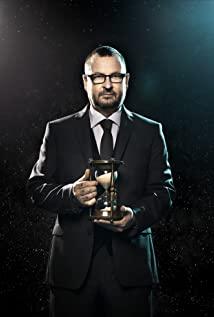"Criminal" brings a new visual experience to the audience, the most striking thing is the film's consistent yellow tone. This tone does not have the warmth and intoxication of the afterglow of the evening sunset, the mellow and elegant coffee color, and the youthful freshness of the lemon color, but an old and ruined dark yellow, which smears the film with an overall sense of decadence. It seems that the whole story is bred on the ruins of civilization. In addition, all the scenes are carried out at night, and with such tones, there is a sense of mystery and depth. In addition to splashing the brown and yellow like ancient scrolls, the image of water has also been highlighted frequently and repeatedly. Dirty and dull water is everywhere in the film, making the environment where the characters are always damp and moldy. A dead horse salvaged from the water always breaks into people's sight. The horse no longer runs, no longer neighs, no longer pulls the wind, but drowns in the water, this strong and powerful image, dead. In addition, there are dim light bulbs, falling leaves, struggling donkeys, glass bottles, scalpels and other dark objects interspersed. The collection of these images creates a picture of a wasteland and apocalypse, so although the crime happened in the electrical age , but it does not have the intoxication and madness of modern cities, but it has the absurdity and coldness of Kafka's fables.
In addition to the pictures, the narrative mode of the film is also quite amazing. The director uses a dream narrative method, which allows the protagonist to recall in hypnosis, back and forth in the three levels of subconscious, preconscious and conscious, and the story flows with the rise and fall of consciousness. As it unfolds, the plot progresses in a blur, and the ending is unreal and indistinguishable, even bringing the viewers into the realm of emptiness. The last two parts of the European trilogy, "The Plague" and "European Express", also follow this peculiar stream of consciousness technique. This narrative strategy makes the film style dark and strange, with the shadows of expressionism and film noir. At the same time, the grass snake gray line is also surreal, and its ambition in form exploration is clearly revealed. Putting on a posture that is not astonishing and dying, the director tried his best to mark the film as "there is no semicolon in this family". ----Forcing film critics to look at the film frame by frame with a magnifying glass, indulging in symbolic analysis, using the film's narrative method as a new film methodology, and naming a new style with the director's name----This is exactly the director of the film desired effect. The early Lars von Trier was the kind of director who would die if he didn't play with form, and in his debut, he was able to be dignified (both holding and posing) all the way to the end, without letting go of his energy, his hands and feet, and his spirit. Completely full of energy, showing complete and absolute control over all aspects of the film. In this film, a policeman finally completes the murder plan of a serial killer through psychological isomorphism and synchronization of behavior. . The story is not wonderful, but the style is too clear, so the comments it has generated are absolutely wonderful. It can almost be said that this is a film specially made for film critics. Its difficult, obscure and ambiguous lens language can detonate countless topics, and the form of the film is paramount. The tendency is more widely debated, and there is no doubt that Russ's film release day is a carnival for academic film critics. ----If there are four ways to write the word "shadow" in a movie, Lars von Trier will definitely create a fifth way.
In common parlance, Lars von Trier's European trilogy presents the same theme: how pure good ultimately leads to evil. This is of course a generalized statement, and specific to each film, it can be discussed at other metaphysical levels. Another translation of the title of "Criminals" is "Criminal Elements". Since it is an element, it is an essential thing, so what are the elements that make up a crime? The answer given by Russ is: people. There are two Greek cultural traditions in Europe. Among them, the Hebrew cultural tradition recognizes that human beings have original sin. Adam and Eve ate apples, and Cain killed Abel. These are sins committed at the source of mankind. As the descendants of sinners, people are born sinners. This is the traditional sense of guilt in Europe, but in modern times, Kafka sensitively shows a sense of guilt with a modern sense in his "The Trial", in which the protagonist is tried without guilt , was eventually shot to death, removed from his religious background, and "sin" was still with him, implying the trembling and guilt of humble individuals in an authoritarian society. No matter ancient or modern, thinking about "sin" is an important factor in European culture. Russ embodies the "consciousness of guilt" in his European trilogy: we look for sinners, but always find ourselves in the end, "I" is the spreader of the plague ("The Plague"), "I" is the murderer offenders ("Criminals"). His reasoning process is: man is a sinner, I am a man, so I am a sinner.
The image analysis, stylistic summary, and thematic refinement of The Criminal above may all be wrong, but I think Lars von Trier welcomes any misinterpretation, because he sets a There is a multi-dimensional and open interpretation space, and he himself will not prepare a set of standard answers there. Since there is no target, there is no off-target. Moreover, misreading is also a big boost to the spread of the film. The director uses hypnosis to blur the boundary between dream and reality. The ocean of consciousness is so profound and unpredictable, there are so many things that emerge, the ground is full of metaphors, and the sight is all symbols. It is not uncommon to write a book around the details in the film. At the edge of the abyss of interpretation, we can only sigh in admiration. So, all that's left is the feeling? Yes, feel the director's far-reaching imagination and the control of the director's command. The second "Plague" in the European trilogy is the director's self-talk about his own film creation. The doctor he plays in the film is the carrier of the plague germ. If "germ" is replaced with "new movie concept", then it is pull Stress's film creation manifesto: I am the destroyer of old rules, and I am the original creator of spreading new ideas of film. Moreover, Russ also anticipated the plague-like destructive power, strong vitality, and rapid spread of his film concepts. Later, when his "Dogma 95 Manifesto" came out, the followers of the movie were even more popular. crowd. Russ advocates the supremacy of the director. In his films, the strong will of the director can be seen everywhere. The form of his films is too aggressive, squeezing the content into the corner, and he likes to set the story time and space as an island or isolation area. In the vacuum state, the characters follow the director's baton to and fro, each with a blurry face. A director who is too strong deprives the audience of their feelings in the real world, so that they can only feel the director's feelings. It is too arrogant to treat the audience like nothing, no wonder some people's attitude towards his films is: go as far as academics, I have to roll my eyes.
View more about The Element of Crime reviews



